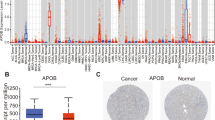Abstract
In this study, the investigation of the expression of HIWI and its protein in hepatocellular carcinoma (HCC) was performed, and the relationships between HIWI expression and the location of HCC metastases were analyzed. Sets of fresh HCC and matched adjacent normal hepatic tissue and paraffin-embedded tissue slides were provided by the hospital hepatology and pathology departments. RT-PCR, Western blot, and immunohistochemistry were performed to detect HIWI mRNA and protein. Correlations between HIWI expression and patient’s age, sex, type of tumor, and metastasis location were recorded. HIWI mRNA and protein levels were significantly higher in HCC tissues than in adjacent normal hepatic tissue (P < 0.05). Immunohistochemistry showed positive staining for HIWI in cell cytoplasm; however, the number of HIWI-positive cells in HCC tissue (65.2%; 60/92) was significantly higher than in adjacent normal hepatic tissue (27.2%; 25/92) (P < 0.05). HIWI expression was not correlated with patients’ age, gender, tumors’ size, and location but correlated with metastasis involving lymph nodes and other remote organs (P < 0.05). HIWI expression is significantly higher in HCC tissue than in adjacent normal hepatic tissue. The results of this study suggest that HIWI may have a crucial role in HCC carcinogenesis and could serve as a potential biomarker or treatment target for HCC.



Similar content being viewed by others
References
Poon, D., Anderson, B. O., Chen, L. T., Tanaka, K., Lau, W. Y., Van Cutsem, E., et al. (2009). Asian oncology summit: management of hepatocellular carcinoma in Asia: consensus statement from the Asian oncology summit 2009. Lancet Oncology, 10, 1111–1118.
Shariff, M. I., Cox, I. J., Gomaa, A. I., Khan, S. A., Gedroyc, W., & Taylor-Robinson, S. D. (2009). Hepatocellular carcinoma: current trends in worldwide epidemiology, risk factors, diagnosis, and therapeutics. Expert of Review Gastroenterology and Hepatology, 3, 353–367.
Thomas, M. (2009). Molecular targeted therapy for hepatocellular carcinoma. Journal of Gastroenterology, 44(Suppl 19), 136–141.
Kuramochi-Miyagawa, S., Kimura, T., Yomogida, K., Kuroiwa, A., Tadokoro, Y., Fujita, Y., et al. (2001). Two mouse piwi-related genes: miwi and mili. Mechanisms of Development, 108, 121–133.
He, W., Wang, Z., Wang, Q., Fan, Q., Shou, C., Wang, J., et al. (2009). Expression of HIWI in human esophageal squamous cell carcinoma is significantly associated with poorer prognosis. BMC Cancer, 9, 426.
Hutvagner, G., & Simard, M. J. (2008). Argonaute proteins: key players in RNA silencing. Nature Reviews Molecular Cell Biology, 9, 22–32.
Lingel, A., & Sattler, M. (2005). Novel modes of protein-RNA recognition in the RNAi pathway. Current Opinion in Structural Biology, 15, 107–115.
Cox, D. N., Chao, A., Baker, J., Chang, L., Qiao, D., & Lin, H. (1998). A novel class of evolutionarily conserved genes defined by piwi are essential for stem cell self-renewal. Genes and Development, 12, 3715–3727.
Qiao, D., Zeeman, A. M., Deng, W., Looijenga, L. H., & Lin, H. (2002). Molecular characterization of HIWI, a human member of the piwi gene family whose overexpression is correlated to seminomas. Oncogene, 21, 3988–3999.
Liu, X., Sun, Y., Guo, J., Ma, H., Li, J., Dong, B., et al. (2006). Expression of Hiwi gene in human gastric cancer was associated with proliferation of cancer cells. International Journal of Cancer, 118, 1922–1929.
Grochola, L. F., Greither, T., Taubert, H., Moller, P., Knippschild, U., Udelnow, A., et al. (2008). The stem cell-associated Hiwi gene in human adenocarcinoma of the pancreas: expression and risk of tumour-related death. British Journal of Cancer, 99, 1083–1088.
Kumagi, T., Hiasa, Y., & Hirschfield, G. M. (2009). Hepatocellular carcinoma for the non-specialist. BMJ, 339, b5039.
Lin, H., & Spradling, A. C. (1997). A novel group of pumilio mutations affects the asymmetric division of germline stem cells in the Drosophila ovary. Development, 124, 2463–2476.
Carmell, M. A., Xuan, Z., Zhang, M. Q., & Hannon, G. J. (2002). The argonaute family: Tentacles that reach into RNAi, developmental control, stem cell maintenance, and tumorigenesis. Genes and Development, 16, 2733–2742.
Lee, J. H., Schutte, D., Wulf, G., Fuzesi, L., Radzun, H. J., Schweyer, S., et al. (2006). Stem-cell protein piwil2 is widely expressed in tumors and inhibits apoptosis through activation of Stat3/Bcl-XL pathway. Human Molecular Genetics, 15, 201–211.
Aravin, A., Gaidatzis, D., Pfeffer, S., Lagos-Quintana, M., Landgraf, P., Iovino, N., et al. (2006). A novel class of small RNAs bind to mili protein in mouse testes. Nature, 442, 203–207.
Kuramochi-Miyagawa, S., Kimura, T., Ijiri, T. W., Isobe, T., Asada, N., Fujita, Y., et al. (2004). Mili, a mammalian member of piwi family gene, is essential for spermatogenesis. Development, 131, 839–849.
Girard, A., Sachidanandam, R., Hannon, G. J., & Carmell, M. A. (2006). A germline-specific class of small RNAs binds mammalian piwi proteins. Nature, 442, 199–202.
Pal-Bhadra, M., Bhadra, U., & Birchler, J. A. (2002). RNAi related mechanisms affect both transcriptional and posttranscriptional transgene silencing in Drosophila. Molecular Cell, 9, 315–327.
Sharma, A. K., Nelson, M. C., Brandt, J. E., Wessman, M., Mahmud, N., Weller, K. P., et al. (2001). Human CD34(+) stem cells express the hiwi gene, a human homologue of the Drosophila gene piwi. Blood, 97, 426–434.
Taubert, H., Greither, T., Kaushal, D., Wurl, P., Bache, M., Bartel, F., et al. (2007). Expression of the stem cell self-renewal gene Hiwi and risk of tumour-related death in patients with soft-tissue sarcoma. Oncogene, 26, 1098–1100.
Acknowledgment
The research was supported by the Science Foundation of Nanjing Science & Technology Bureau (Proj. No. 210ZD220).
Conflict of interest
The authors declare that they have no competing interests.
Author information
Authors and Affiliations
Corresponding author
Rights and permissions
About this article
Cite this article
Jiang, J., Zhang, H., Tang, Q. et al. Expression of HIWI in Human Hepatocellular Carcinoma. Cell Biochem Biophys 61, 53–58 (2011). https://doi.org/10.1007/s12013-011-9160-1
Published:
Issue Date:
DOI: https://doi.org/10.1007/s12013-011-9160-1




